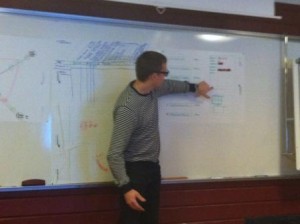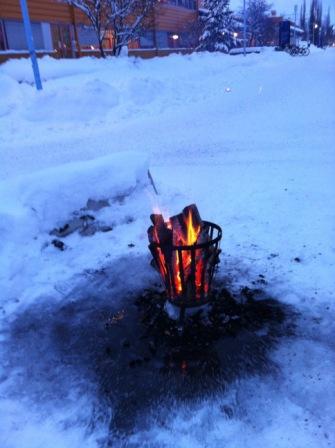Let me tell you about an educational experiment we’re doing. It might help us meet our future so read on. You know how professionals sometimes look for future developments and markets talk to kids to see what makes them tick? At Luleå University of Technology where I hold an adjunct professorship we thought we’d test that. The Department of Civil, Environmental and Natural Resources Engineering is currently giving a course in Lean construction (syllabus here) which includes a unit where students are expected to develop their own business plan for an innovation they come up with.
Here’s the thing. We’ve given them lectures on project-based construction for close to four years and are now teaching them how the parts fit together in lean construction and systems building. We’ve learned over the years that this combination sets their creativity off. They see the voids in our transition from project-logic to product-logic and get ideas on how to fill that need. The business ideas are by necessity often a bit naive, but the analyses of the weaknesses of our sector are usually spot-on.
This is where the curriculum steps in and we ask them to develop their plan as a part of their education. They get to develop an idea into a business plan for a need they consider representing a market. They are then put in front of some of our industry colleagues who assess their ideas. Would we support it, even finance it? The students go up against people like an industry researcher, a CEO of a prefab housing company, a government financer of innovation, a professor of economics, the university lawyer and so on. The real-world people that assess them make the students do their very, very best. And because our students can expect some scary moments in that workshop they are well prepared and thus leave a good bit wiser, considerably more confident and well relieved. The teachers and the assessing jury get insight into what some of our soon-to-be professionals react to in our sector. That’s something that makes us tick too, so we’ve been thinking how we can share those insights with you.

Professionals at all levels need to be able to quickly make the essence of complex information come across to someone.
We thought we’d simply build on your curiosity and that teachers take every opportunity to teach. In this exercise our students will learn to analyse a situation, bring out the key features of it and then make their point logically in a short text. Normally they only go through the motions of doing this. Reason? They are writing for a teacher’s drawer, likely second from the bottom on the right hand. Next to the dustbin, if not in it. Starting around March 1st, we’re doing away with that and using this blog as the platform.
As you are reading this, our students are busy articulating the need they’ve decided to work with. We’d like to share with you their thoughts. See what you think, you know? Maybe we’ll all learn something from this open approach. We did something similar in Swedish in 2010, where the students were asked to define some words relevant to the curriculum and upload them to Wikipedia. You’ll find the links to their efforts here. This time around, you’ll get tailored guest blog posts from five groups of students, each group describing a perceived weakness in the construction industry. If you agree with something, pick it up and run with it. If you see something you disagree with, feel free to comment!
You won’t be alone, since this is the first blog post of mine to be written specifically for both my own blog and the new site www.100innovationer.com, the new exhibition of innovation at the National Museum of Science and Technology in Stockholm. That’s where I grew up; in their mine, by their miniature railway, and in the various machines they exhibit. I’ll wager that’s where I once decided to become an engineer. I think listening to kids and students talk about my profession is not only necessary for the development of the sector It is also useful, challenging and good fun.
Readers, may I present our students? Students? Readers. Now behave yourselves. Not.
Images: Dan Engström, Creative Commons by-nc-sa


 Facebook
Facebook
1 Pingback